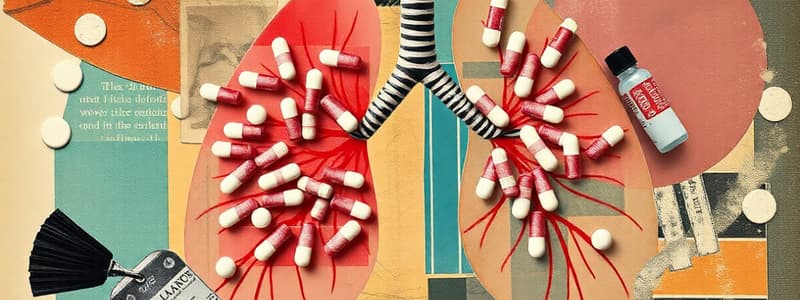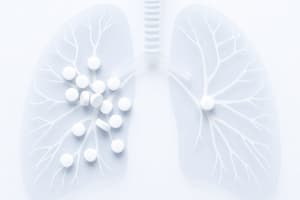Podcast
Questions and Answers
Flashcards are hidden until you start studying
Study Notes
Respiratory System Drugs
- Respiration is the exchange of gases between the atmosphere and the cells of the body. Ventilation is bringing fresh air in.
- Upper respiratory tract includes nares, nasal cavity, pharynx, larynx, and trachea
- Lined with epithelial cells containing cilia
- Cough receptors mainly found in the pharynx and trachea. Suppresses non-productive coughs.
- Diseases: congestion, sneezing, and coughs.
- Lower respiratory tract includes trachea, bronchi, bronchioles, and alveoli.
- Bronchioles have smooth muscle
- Sympathetic stimulation = bronchodilation (relaxation of muscle)
- Parasympathetic stimulation = bronchoconstriction (contraction of muscle).
- Alveoli produce surfactant to keep them open by reducing surface tension
- Diseases: asthma, bronchitis, pneumonia, recurrent airway obstruction ("heaves" in horses).
- Respiratory Drugs
- Expectorants: increase respiratory secretions to allow material to be coughed up; increase mucus fluidity. Example: Guaifenesin
- Adverse Effects: mild decrease in blood pressure (BP) and increased heart rate (HR).
Mucolytics
- Decrease the viscosity (thickness) of respiratory secretions. Example: Acetylcysteine
- Adverse Effects: vomiting, hives (rarely), potential chest tightness, irritation.
Antitussives (Cough Control)
- Suppresses coughs (productive or not usually suppressed).
- Can be centrally acting (brain stem) or locally acting (mucosal linings).
- Central acting antitussives can cause respiratory depression. Examples: opioids (Butorphanol, hydrocodone, codeine), Dextromethorphan.
Decongestants (Reduce Swelling)
- Decrease congestion in nasal passages by reducing swelling
- Examples: sprays, liquids, tablets.
- Examples: Phenylephrine, pseudoephedrine
Bronchodilators
- Widen the lumen of the bronchi (widening the airways).
- Example: Stimulation of Beta-2-adrenergic-agonists which are involved in bronchodilation. and stabilization of mast cells. (Epinephrine, isoproterenol, Terbutaline, albuterol)
- Methylxanthines: Inhibit an enzyme in smooth muscle. Examples include Aminophylline & theophylline.
- Adverse effects: Nausea, vomiting, CNS stimulation (increased heart rate, etc.)
- Antihistamines block H1 receptors to reduce bronchoconstriction, increased HR, vasodilation, CNS sedation, and inflammatory response. Examples: Diphenhydramine & chlorpheniramine.
- Adverse effects include: CNS depression, dry mouth, and urinary retention.
Respiratory Stimulants
- Stimulates the animal to increase respirations. Example: Doxapram.
Respiratory Diseases
- Asthma (feline) - chronic inflammatory disease of lower airways caused by inhaled allergens causing smooth muscle contraction.
- Recurrent Airway Obstruction (ROA): treated by maintaining horses in a good environment and medication.
- Infectious Tracheobronchitis (Kennel cough)
Hormonal and Reproductive Drugs
- Hormones are chemical messengers produced by cells in one part of the body and transported to another part. Endocrine glands involved: pituitary, thyroid, parathyroids, adrenal, pancreas, thymus, pineal, gonads.
- Hormones are regulated via feedback loops
- Some drugs can replace or increase/decrease hormone production.
Blood Glucose Regulation
- Pancreas secretes insulin and glucagon to regulate blood glucose levels.
- Insulin helps increase the uptake and use of glucose by cells.
- Glucagon promotes glycogen breakdown to increase blood glucose levels.
- Hypoglycemia is low blood glucose- treated by reducing symptoms and avoiding hypoglycemia.
Insulin Regulation
- Short-acting, Intermediate-acting, Long-acting, Ultra-long-acting. Work on maintaining stable blood sugar.
- Oral hypoglycemic agents work by stimulating pancreatic beta cells to secrete insulin.
- Examples of oral hypoglycemic agents include Glipizide, and others.
Urinary System Drugs
- Kidneys: filtration of blood, reabsorption of essential substances, and secretion of waste products.
- Glomerulus filters substances out of the blood.
- Tubules reabsorb needed substances, or excrete substances back into plasma. Substances filtered include: water, glucose, amino acids, ions.
- Waste products are part of urine.
- Disorders: UTI's, renal failure, urolithiasis, feline lower urinary disorders, urinary bladder cancer, bacterial infections, etc.
Types of Urinary Drugs
- Diuretics: increase urine volume (e.g., Loop diuretics, Potassium-sparing diuretics, Thiazides, carbonic anhydrase inhibitors, Osmotics); these function in different parts of the nephron to eliminate excess water.
- Urinary acidifiers modify pH to treat stones in the urinary tract.
- Urinary alkalinizers raise urine pH to treat some types of stones.
Antihypertensives
- Angiotensin-converting enzyme (ACE) inhibitors
- Angiotensin receptor blockers (ARBs)
- Calcium channel blockers
- Beta-adrenergic antagonists (Beta-blockers).
Anti-ulcer Drugs
- Antacids, histamine-2-receptor antagonists, mucosal protective drugs, prostaglandin analogs, proton pump inhibitors.
Studying That Suits You
Use AI to generate personalized quizzes and flashcards to suit your learning preferences.




